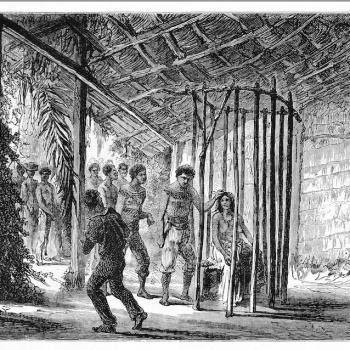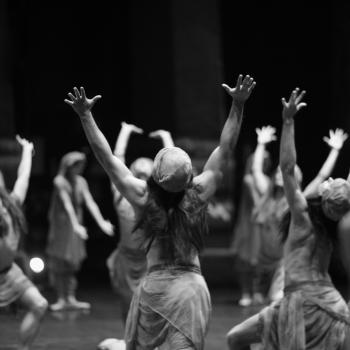Connor Wood

From the somber Catholic high mass to the painful, often frightening initiation rites of many tribal cultures, every human society practices some form of ritual. But the rituals themselves differ radically – in ways that may be predictable across cultures. Namely, new research shows that complex cultures that depend on agriculture tend to have frequent, repeated rituals that are relatively sedate and calm. Smaller cultures with less agriculture, on the other hand, feature rituals that are less frequent but far more emotionally and physically arousing. Ultimately, these trends may give us a vital clue as to how human culture changes over time.
 To explain what this might mean, let’s return to the two examples of ritual mentioned above. Imagine a Catholic mass: you’re standing in a pew, reciting the Lord’s prayer. Maybe a hundred other people around you are all mumbling the prayer in time, their voices echoing dully in the nave. Soon, the priest will consecrate the mass, and you and the other congregants will either stand or kneel to receive dry communion wafers and wine: the Eucharist. This ritual is repeated every week.
To explain what this might mean, let’s return to the two examples of ritual mentioned above. Imagine a Catholic mass: you’re standing in a pew, reciting the Lord’s prayer. Maybe a hundred other people around you are all mumbling the prayer in time, their voices echoing dully in the nave. Soon, the priest will consecrate the mass, and you and the other congregants will either stand or kneel to receive dry communion wafers and wine: the Eucharist. This ritual is repeated every week.
Next, imagine partaking in a subsaharan African initiation ritual. You and maybe a half-dozen other adolescent boys are removed from your village and isolated in the bush for a week. You are required to fast for the entire time as you spend hours each day painstakingly learning the mythology and history of your tribe from an elder. You are allowed to sleep little each night. By the end of the initiation period, you can barely stand up from lack of food and sleep. It’s then that the elder finally circumcises you and the other boys – with a sharp, jagged rock. Only now are you a man.
These two vignettes exemplify what many researchers think are complementary modes of religious ritual across cultures. The first, featuring relatively low-intensity, regularly repeated rituals, activates our semantic memory by slowly carving out grooves in our minds, forging connections gradually over long periods of time. By partaking in these semantic rituals, we learn the doctrines and beliefs of our tradition by insistent repetition and constant, low-level exposure.
The second ritual mode, which depends on what cognitive scientists call episodic memory, is a different beast entirely. These rituals are highly emotionally arousing, often painful or even traumatic, and have been postulated to take place less frequently than their low-intensity, semantic counterparts. We remember the contents of these rituals not because they wear themselves persistently into our memory, but because they burn themselves into it in a flash. (Indeed, the vivid, one-time episodic memories this sort of ritual is thought to generate are referred to as “flashbulb memories” by experts.)
But while theorists have hypothesized that the first ritual mode, also known as the “doctrinal” mode, is usually enacted more frequently (say, every Sunday) and the second, or “imagistic,” mode less frequently (once a year, or even once in a lifetime), there was no solid proof of this model until recently.
Oxford University anthropologists Quentin Atkinson and Harvey Whitehouse changed this by conducting a study in which they methodically examined data from more than 70 different cultures, hoping to discover patterns in the immense richness and variety of human societies. They hypothesized that rituals that were highly emotionally arousing – any ritual that included exciting, vivid elements like loud music, dancing, yelling, or physical hardship – would be carried out less frequently than more humdrum rituals based on liturgy, repetition, and solemnity, basing their guesses on the existing models of memory and ritual. Furthermore, because ritual styles vary significantly across cultures as well as within them, Atkinson and Whitehouse expected that low-intensity, semantic rituals would be more common in highly complex, urban cultures, while high-intensity, imagistic rituals would prevail in smaller, less rigidly organized societies.
Their results clearly supported most of their hypotheses. Using independent raters to gauge the emotional intensity of rituals from 74 cultures in the Human Relations Area Files – a massive compendium of anthropological data for societies around the world – the researchers found that the frequency of ritual enactment was inversely proportional to intensity. That is, the more emotionally arousing a ritual is, the less often it’s likely to be carried out.
What’s more, it was the negative emotional intensity of rituals that was the strongest predictor of a ritual’s frequency. Rituals that elicited intense but positive emotions were sometimes carried out quite often, while strongly painful or aversive rituals – like adolescent circumcision rites – tended to be enacted very rarely.
At the societal level, cultures with high levels of agriculture were much more likely to take part in low-intensity, high-repetition rituals than societies with less agriculture. The authors hypothesized that the low-intensity rituals of world religions such as Christianity or Islam may help people band together in larger social groups, because the relatively weak but sustained effects of such rituals encourage spreading out one’s commitments across many people and groups. Meanwhile, the sharper, infrequent imagistic rituals that characterize smaller cultures may encourage stronger – more focused – bonding with only a select group of people. Such high-intensity bonds may be better for hunter-gatherer and tribal cultures, where people depend more on durable, tight-knit relationships and less on far-flung webs of acquaintances and associates.
In other words, rituals that require regular, repeated participation may arouse few exciting emotions, but they may also be ideal for forging the low-intensity, reliable bonds of mutual association that are vital for life in large, anonymous societies. In small-scale societies, high-intensity rituals may be the better choice, because they focus partakers’ emotional energy on a tight-knit group.
These predictions may have implications beyond the field of religion. They might, for instance, help explain the use of painful or emotionally distressing initiation rituals in urban gangs. Perhaps gang members, feeling alienated from the low-intensity, high-repetition ritual life of the larger North American society, find it necessary instead to focus their emotional energy on a tight-knit core of trusted fellows. Indeed, for marginalized young males in urban contexts, such small-group behavior may make sense. The high-intensity, often shocking initiation rituals that such gangs inflict on their members could then be interpreted as a form of imagistic ritual, similar to a circumcision rite: painful, burning themselves immediately in the initiate’s memory, such rituals leave little doubt afterwards as to one’s identity, one’s place in the world. They don’t need to be repeated often, because the pain and the thrill are already enough.
Click here for the original paper, “The Cultural Morphospace of Ritual Form,” in the journal Evolution and Human Behavior.











